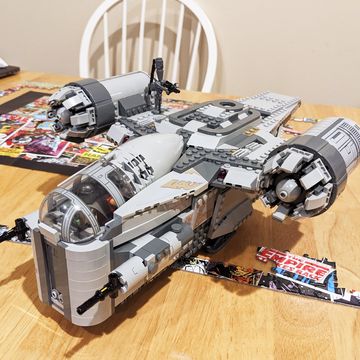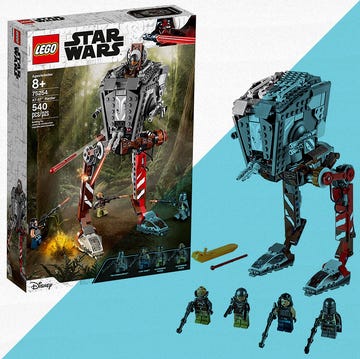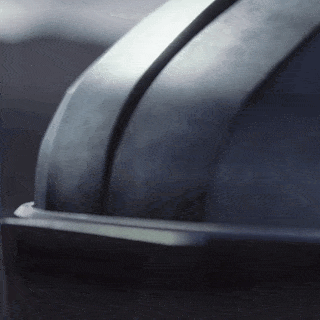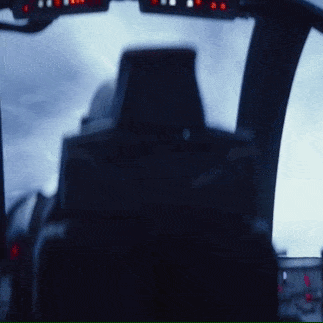The Star Wars films are great escapist fantasies, and like all escapist fiction, it's best not to think about it too much. The films take place, as the saying goes, "a long time ago, in a galaxy far, far away," where apparently almost everything is possible.
Still, there are some things about the spaceships of the Star Wars movies that don't make any sense if you think about them even a tiny bit. Some are just bad design no matter what the technology, others could explained away if we—or anyone for that matter—knew exactly how things worked. Here are five examples.
The TIE Fighter
Mainstay of the Galactic Empire's fighter force, the TIE fighter is a pretty menacing aircraft. The Twin Ion Engine (TIE) fighter has two such engines—somewhere—and like a World War II Stuka attack plane makes a menacing screeching noise as it passes by.
The biggest drawback of the TIE fighter are the flat panels on both sides that make it look like an eyeball suspended between two playing cards. This is a large vertical surface area that seemingly serves no purpose—except to be a large aiming point for Rebel Alliance fighters.
Another problem with the panels is they restrict pilot visibility. The F-16 Viper has excellent visibility, thanks to a bubble canopy with the pilot in the center. The F-35 Joint Strike Fighter has poor visibility, but the Distributed Aperture System helmet is expected to help the pilot "see" 360 degrees.
The poor TIE fighter pilot on the other hand has two large panels on both sides of him, preventing him from seeing anything more than perhaps a 50 degree cone in front of him. He would be unable see other TIE fighters flying abreast of him, or even in a staggered formation—unless he had a Distributed Aperture System helmet, too.
Super Star Destroyer
An enormous starship the length of sixty US Navy supercarriers, the Super Star Destroyer was an improvement on the standard Star Destroyer. The first of the class, Executor, was Darth Vader's flagship.
The question is: Why bother to build the Super Star Destroyer at all? Although much, much larger than the average Star Destroyer, it doesn't have larger, more powerful weapons. The whole point of building a larger ship is to put larger weapons on it.
Imagine if, when navies built battleships, larger ships still mounted the same guns as destroyers and cruisers. Bigger weapons extended the range of the fleet, and allow the fleet to give individual ships some breathing room.
This would have come in handy during the Battle of Endor, when a single Rebel A-Wing fighter crashed into the bridge of the Executor. The 11-mile long ship went out of control, causing it to collide with the Death Star II. When a tiny fighter can take down your flagship, and, in a domino sequence, your primary battle platform, you've got some serious engineering issues.
The Snowspeeder
A smallish, two-seat atmospheric fighter, the Snowspeeder was first seen at the Battle of Hoth, when Rebel forces used them to provide cover during the planet's evacuation.
In addition to the twin fixed-laser blasters, the Snowspeeder features a rear-firing harpoon. The harpoon attaches to a powerful, flexible cable which can be detached from the aircraft.
The plan is to use Snowspeeders to destroy the AT-AT walking tanks by firing a harpoon into it. (Somehow, the armor is too powerful for blasters, but not powerful enough to stop a magnetic metal spear.) The Snowspeeder would then do donuts around the AT-AT, wrapping the gigantic machine's massive legs in cable, and then cutting loose as the AT-AT is tripped up and falls.
The plan is extremely dangerous for the Snowspeeder crew. If the cable draws taut around the AT-AT's legs, that would put a tremendous amount of force on the aircraft's airframe, possibly enough to break it apart mid-flight. In addition, Snowspeeder pilots would be subjecting themselves to tremendous g-forces, especially as their aircraft whips around in ever tighter circles, greatly increasing the risk of unconsciousness as they fly very close to a very large object.
If the Rebels insisted on using galactic-strength piano wire to take down an AT-AT, they could have buried cables in the ground, under the snow, and raised them just as the AT-AT passed it by. This would have allowed the Snowspeeders to concentrate their blaster fire against enemy ground forces, particularly the smaller AT-ST walkers and individual snowtroopers.
Trade Federation Droid Control Ship
Many of the military organizations in the Star Wars universe suffer from—in addition to a lack of marksmanship training—severe command-and-control problems.
Trade Federation Battleships were actually decent starships, and according to Star Wars canon were converted freighters. The donut-shaped design would have made landing starfighters difficult, but that's not the battleship's biggest flaw.
The Droid Control Ship was responsible for controlling the ground invasion force during the Battle of Naboo. The entire ground invasion force. Of 139,000 droids.
When young Anakin Skywalker accidentally flew into the Droid Control Ship and set off a chain reaction that destroyed it, the entire droid force on the ground was deactivated, foiling the invasion. There was no backup control to keep the droids functioning in case the Droid Control Ship was deactivated.
The Droid Control Ship had one job to do, and it did it badly.
The X-Wing fighter
Singling out the X-Wing is a good way to get on the Star Wars fan base's bad side. The gripe here isn't with the iconic fighter itself, rather we're going to use it as a stand-in for all the little things about Star Wars ships that make no sense.
The control systems of Star Wars space ships make no sense. How, for example, do they slow down? Without gravity, the X-Wing would need reverse thrusters to slow itself, or turn itself around and fire its engines in the opposite direction—and yet we know it does neither.
How do ships in the Star Wars universe change direction? The X-Wing has four engines, but seemingly has no way to change direction. It could change the amount of thrust to individual engines to bank or turn and—assuming this is possible—the more engines the finer the control. But even if this were possible, aircraft-like maneuvers the X-Wing is famous for would be a real stretch.
Finally, like a lot of Star Wars spaceships, there's just not enough ship. How does a tiny fighter like the X-Wing travel from the Hoth system to the Dagoba system all by itself? Again and again in the Star Wars movies, small ships travel vast distances apparently using some ultra-compact fuel supply.
Speaking of which, how did Luke Skywalker fly that long distance without going stir crazy in his cockpit? Hopefully the X-Wing comes preloaded with some decent in-flight movies.

Kyle Mizokami is a writer on defense and security issues and has been at Popular Mechanics since 2015. If it involves explosions or projectiles, he's generally in favor of it. Kyle’s articles have appeared at The Daily Beast, U.S. Naval Institute News, The Diplomat, Foreign Policy, Combat Aircraft Monthly, VICE News, and others. He lives in San Francisco.














